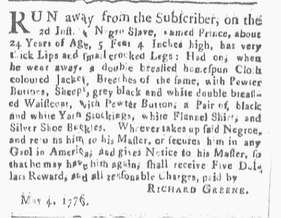Prince Greene
In 1777, while he was enslaved by Richard Greene, he enlisted as a Private in the 1st Rhode Island Regiment to pursue his freedom in the Continental Army during the American Revolution.
[6] Historian Robert Geake, in his book From Slaves to Soldiers, writes that Prince Greene was "listed in the 1777 military census and was no doubt eager to enlist in this opportunity for freedom.
On April 10, 1781, in Providence, Rhode Island, while the town was still under martial law, young residents often challenged the local militia and Continental troops after a night of carousing.
[1] According to historian John Wood Sweet in his book Bodies Politic, the barracks were adjacent to the Rhode Island State House to protect the local gunpowder reserve.
Sweet also notes, "The two assailants were men of prime fighting age—Edward Allen was twenty-three—but neither seems to have served in the local militia or in the Continental Army.
The musket ball hit its mark with remarkable precision: it struck the back of Allen's head, bored a hole about an inch in diameter, and shot through his forehead.
The victim's mother, Elizabeth Allen, outraged by what she saw as a lack of justice, commissioned the Hartshorne gravestone carvers of Newport to furnish his stone in Providence's North Burial ground, which recounts his "misfortune of being shot by a negro soldier," an act "Most barbarously done.
"[1] Sweet writes, "For many years, Edward Allen's epitaph stood as one of the only public commemorations of black military service in the Revolutionary War.
"[1] According to historian John Wood Sweet, Prince Green, like many other veterans, "returned to a weary, economically depressed, and seemingly ungrateful homeland.
According to the Rhode Island Historical Cemetery Commission, his gravestone was carved by one of the enslaved Black stonemasons from The John Stevens Shop.

